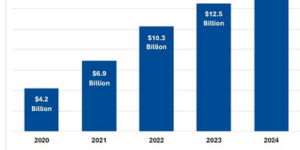David Miller is a stickler for safety at the Goodwill stores he runs in central California. So when Applied Underwriters offered his nonprofit a deal on insurance for workplace accidents if he could minimize injuries, he jumped at the opportunity. Even better, Applied was part of Berkshire Hathaway Inc., the firm controlled by Warren Buffett.
These days, he wishes he hadn’t. The contracts Miller signed have turned into a burden for his organization. It paid $1.8 million to cover about 350 employees, many disabled or disadvantaged at 17 locations from Lodi to Visalia. When the nonprofit switched carriers last year, Applied demanded hundreds of thousands of dollars more to fund remaining claims.
“I’m trying to make money in my stores to help people,” said Miller, chief executive officer of Goodwill Industries of San Joaquin Valley. “Instead, I’m writing big checks to an insurance company that I probably don’t even owe.”
Miller’s nonprofit is one of dozens of employers—from a bike-courier service in Manhattan to a linen-supply company in Sacramento—that have sued Applied for deceptive practices. The businesses allege the insurer peddled products regulators hadn’t approved. They complain about being surprised by large bills based on formulas that stacked the deck in the insurer’s favor. California, Vermont and Wisconsin have banned some Applied plans.
The insurer says that its products save employers money and that customers were aware of the terms. Companies that are litigating account for only about one in 400 policies sold, said Jeffrey Silver, Applied’s lawyer. The plans didn’t work out in their favor because they had claims that caused costs to go up, he said. They’re now “taking advantage of a regulatory situation” to avoid paying what they owe. About 90 percent of employers renew, Silver said.
The Berkshire subsidiary agreed to orders by regulators in California, Vermont and Wisconsin to halt some of its sales. But the company continues to press its case in California, its largest market, where it has asked a state court judge to overturn the insurance commissioner’s decision that its plans were illegal.
“It’s an innovative product,” Silver said. “And sometimes when you have an innovative product, regulators take a while to catch up to it. And that’s exactly what we think is happening here.”
As courts weigh these quarrels, this much is clear: It’s a lot of hot water for one of Buffett’s companies. The billionaire, who didn’t respond to requests for comment, tells Berkshire managers that “there’s plenty of money to be made in the center of the court.” In other words, no need to get close to the line, legally or ethically, to make some extra bucks.
Yet Applied has done just that, according to court filings, public records and interviews with more than two dozen business owners, brokers, consultants, attorneys, regulators and former employees of the insurer. Together, they describe a company that profits by enticing employers to make a financial gamble, even though some say they didn’t fully understand the rules.
Early Days
Sid Ferenc, a former vice president of finance at Newsweek, started Applied in the San Francisco Bay Area in 1994 with Steven Menzies, a math whiz with a degree from Columbia University. Small companies would hire them to arrange workers’ compensation coverage and handle payroll and tax reporting.
Eventually, they purchased a company to provide insurance directly. By bundling policies with a service that sent paychecks to workers, Applied got direct access to payroll information, a key component to pricing coverage.
Buffett warmed to the business after a top lieutenant, Ajit Jain, wrote a reinsurance policy for Applied, taking on some of the company’s revenue and risk. In 2006, Berkshire bought 85 percent of the insurer, which by then had moved most of its operations to Buffett’s hometown of Omaha, Nebraska. The sale price wasn’t disclosed, but Menzies later said in a legal filing that he received more than $60 million. He and Ferenc “started on a shoestring only 12 years ago,” Buffett wrote in a 2006 letter to investors, “and it will be fun to see what they can accomplish with Berkshire’s backing.”
Even then, there were signs Applied didn’t always play in the center of the court. In 2004, California said the company owed $27 million for evading state unemployment taxes. Applied fought the matter in court and lost. Ferenc and Menzies declined to comment for this story.
Loss Sensitive
Around the time Berkshire bought a controlling stake, Applied introduced new products. Big employers already could buy workers comp coverage in which premiums were adjusted based on actual claims. Such so-called loss-sensitive plans could save money if an employer operated without major accidents, but they could be pricey to set up and so complex that they were better-suited for sophisticated businesses with resources to handle the expense if claims piled up. That’s why some states have been reluctant to let insurers sell certain types of loss-sensitive coverage to small firms.
Menzies and other Applied executives devised and patented a workaround. It started with a workers’ comp policy that was filed with state regulators and looked like what most small businesses buy. The math on these kinds of fixed-cost plans is usually simple and standardized. States say what factors can be used to determine premiums and set rates insurers can charge for different types of work. Those rates are then multiplied by a company’s payroll.
Applied added a layer of complexity with what the insurer called a “profit-sharing plan,” according to sales documents and court records. Employers were required to fund an account that would reinsure, or backstop, a portion of Applied’s losses. If the business didn’t have any claims, the plan would deliver substantial savings over the basic policy. But, if there were injuries, the cost would climb, up to a guaranteed maximum.
Just how much had to be held in the account, and what the final bill would be, was governed by a dense legal document. Business owners and their brokers had to make sense of “loss development” and “exposure group” factors, as well as terms like “cession point,” “loss pick containment amount” and “run-off term.” Customers and their brokers often saw the agreement only toward the end of the sign-up process, according to court records.
Applied didn’t file this second contract, which it called a “reinsurance participation agreement,” with regulators. The company would later say in court filings that was because the document, despite its name, wasn’t technically insurance and didn’t alter the terms or obligations of the filed policy. “Our position is it’s part of a reinsurance transaction that doesn’t need to be filed,” Silver said.
James Moore, a workers’ comp consultant with more than two decades of experience, remembers analyzing some of Applied’s plans for clients around 2009 to see whether their bills were accurate. At first, he said, he was “baffled” and had to spend hours sorting out the calculations, which turned out to be correct. “The normal business owner never would have been able to figure it out.”
Driving Factor
Anthony Will was the kind of business owner Applied hoped to reach with its new product. His firm, West Coast Welding Inc., specialized in driving piles into the ground for bridge foundations. It’s dangerous work that insurers charge a lot to cover, but Will thought he and his co-owners could run a safe operation and save money.
The Pleasant Hill, California-based company, which had about 15 employees at the time but could scale up to 40, got a quote from Applied in 2007 that showed its cost under the plan would be at least $458,412 for three years and wouldn’t exceed $819,993. Will said the plan looked competitive with those of other carriers. He also liked Applied’s ties to Berkshire.
“That was one of the big, driving factors,” Will said. “You’re not dealing with Fred & Tom’s insurance, which will be out of business tomorrow.”
Things didn’t work out as he hoped. At the end of the contract, Will figured his business should get back about $100,000 because he only had a few thousand dollars in claims. More than six years later, he’s still waiting for a check. He sued in February. Applied tried to move the dispute into arbitration, but a judge blocked the transfer. Applied is appealing.
“We agreed that they’re entitled to some final distribution,” Silver, Applied’s lawyer, said. “We don’t think it’s $100,000, and we believe it’s far from that.”
Marketing Push
The insurer marketed its policies to independent brokers through an internal sales force. Applied’s managers tracked performance closely, according to former employees who asked not to be identified for fear of retaliation. These people said the profit-sharing plans were very complex and could be a bad deal for customers, in part because of harsh cancellation terms—a characterization echoed this year by California’s insurance regulator. Silver said the cancellation penalties are actuarially determined and no worse than similar policies.
Ferenc, the CEO, left most day-to-day decisions to Menzies, the president, who ran the company with a small cadre of executives, former employees said. Everyone else was kept in the dark about matters outside their department. One former worker described Menzies as the Wizard of Oz—the man pulling strings behind the curtain whom few people ever met.
Outside brokers who brought in business could win cases of wine, TaylorMade golf clubs or, for star performers, a trip to Napa, including airfare, hotel, rental car, a hot-air balloon ride and a tasting at a faux 13th-century Tuscan castle and winery—all spelled out on an Applied website promoting sales of its products.
It’s hard to pinpoint Applied’s profit. The unit accounts for just a sliver of Berkshire’s insurance business, which also includes GEICO and contributed about one-fifth of the $24 billion of net income at Buffett’s firm last year. But state regulatory filings show how lucrative Applied’s workers’ comp plans were. Net income at California Insurance, one of the company’s largest subsidiaries, rose to $65.5 million in 2014 from a loss of $4.4 million five years earlier.
Margins were fat, too. The same subsidiary made more than 35 cents on each dollar in premium revenue it collected every year from 2010 to 2014, while workers’ comp insurers in California posted, in aggregate, an underwriting loss, according to the state’s insurance regulator.
Buffett must have been pleased. Ferenc and Menzies got paychecks that rivaled those of some Berkshire senior executives. In 2015, each made about $9 million from salary, bonus and other compensation, according to a filing with the Nebraska Department of Insurance. That compares with Jain, who was paid $11.8 million that year by the company’s much larger insurance carrier National Indemnity.
Shasta Linen
Shasta Linen Supply got a quote from Applied in 2009 and signed up for a three-year plan. When it came to a close, the bills didn’t stop, even though the company, which employed about 60 people, had already paid more than $900,000 for coverage. Applied wanted an additional $244,213.
Shasta refused to pay, arguing that the additional fees exceeded its obligations under the state-approved policy and weren’t fully explained. In 2014, Shasta appealed to the California Department of Insurance, challenging the plan’s legality.
After a lengthy proceeding, California Insurance Commissioner Dave Jones ruled in Shasta’s favor in June, declaring Applied’s reinsurance-participation agreement illegal and void. His 70-page decision laid out how Applied had circumvented regulatory oversight to boost its profit. The insurer, he wrote, fundamentally changed the terms on a state-approved workers’ comp plan, putting the burden of claims back on the employer.
There were other troubling facets of the plans, Jones said: Applied imposed steep fees on customers that canceled early or decided not to renew, and it had the right to hold excess payments from customers for as many as seven years after a policy ended.
“This is a case of, ‘If it sounds too good to be true, it probably is,'” Jones said in a statement.
The commissioner noted that two other state regulators had already prohibited some of Applied’s products. Last year, Wisconsin ordered the company to stop renewing and selling plans with reinsurance participation agreements. The regulator then fined the insurer $140,000 when it failed to comply. This year, Vermont’s Department of Financial Regulation announced that between 2007 and 2015, Applied had overcharged dozens of small businesses. The insurer agreed to rebate $352,000 to customers and pay a $300,000 fine, one of the largest levied by the regulator against an insurer since 2009.
Other states are weighing in. Virginia’s regulator says it’s reviewing actions by regulators and whether Applied is complying with the law. Officials in Minnesota said this week that they’re looking into Applied’s reinsurance participation agreement. Maryland’s regulator sided with Applied, saying the company doesn’t need to file the contracts.
Jones’s rebuke provided fodder for attorneys pursuing cases against the insurer. In September, New York bike-messenger service Breakaway Courier Corp. drew on Jones’s decision in a lawsuit that accused Applied and Berkshire of siphoning premiums for their own benefit. Silver called the case frivolous.
Applied agreed to stop selling the plans in California but countered in a court filing in July. It said the commissioner and administrative law judge presiding over the Shasta case “acted in excess of their powers” and didn’t give the company a fair trial. The insurer argued its coverage fell into a category of plans that aren’t subject to rate and filing requirements and that the regulator hadn’t raised any objections about the plans during multiple examinations.
Applied also said Shasta willingly signed up for the plan, and its president was an experienced lawyer who had the help of an independent broker. It added that the profit-sharing plan would have saved Shasta money over its fixed-cost policy had the employer continued to pay bills.
Support Letters
Silver, the Applied lawyer, said most employers are happy with the company’s products. To prove his point, he provided five letters sent this year to California’s insurance commissioner by brokers and one customer, the San Francisco Opera, urging that the policies continue to be made available. What wasn’t mentioned: One broker, Carl DeBarbrie, is a former Applied executive. Menzies is vice chairman of the opera’s board.
DeBarbrie, who brokered the policy for the opera, said Menzies wasn’t involved in the decision to send the letter. “This was something that our client and I felt was appropriate given their experience,” DeBarbrie said. Jeffery McMillan, a spokesman for the opera, declined to comment.
Meanwhile, the situation was taking a toll on Applied. In October, the company filed a document in the court case saying negative publicity had caused brokers to stop signing clients with the insurer. Applied said it was also seeing a surge in customers canceling policies.
Goodwill Lament
When employers can’t pay their bills, Applied offers them a payment plan. Goodwill’s Miller signed one of these IOUs last December for $454,132, the amount the insurer said he owed after his policy ended, plus interest. He’s still bothered by it, even though Applied said in August his organization’s bill had been revised down to about $60,000.
Miller’s Goodwill stores and other operations pull in about $20 million a year in revenue, almost all of which goes to support programs and services. He runs monthly safety meetings with store managers, as he has for the past 13 years. They go over any accidents and conduct training programs to cut down on injuries. It all helped keep claims so low, Goodwill said in its lawsuit, that Applied should send his organization money.
Silver, the insurer’s lawyer, says it’s impossible to know the final accounting for the plan because the nonprofit still has open claims. In any event, he said, Goodwill was represented by a professional broker and had an opportunity to review all the documents. In March, Applied filed a lawsuit in Nebraska, demanding the funds.
“Applied pulled the wool over everybody’s eyes,” Miller said. “Had it all been presented upfront— ‘here’s the risk you’re taking’—I never would have done it.”





















 Don’t Forget Workers Comp Tariff Impacts: Berkley
Don’t Forget Workers Comp Tariff Impacts: Berkley  Wildfire Losses Cut Chubb Q1 Net Income 38%; Tariffs Create ‘Confusion’
Wildfire Losses Cut Chubb Q1 Net Income 38%; Tariffs Create ‘Confusion’  The Future of the Insurance Customer Experience Is Unity, Personalization
The Future of the Insurance Customer Experience Is Unity, Personalization  Lemonade: 700K Customers on the Car Waitlist
Lemonade: 700K Customers on the Car Waitlist 

